The winners of the annual Wood Awards have been announced at a ceremony held yesterday (21 November) at Carpenters’ Hall in London
Hosted by Johanna Agerman Ross, Founder of Disegno magazine and Curator of Twentieth Century and Contemporary Furniture and Product Design at the V&A, the Wood Awards is the UK’s premier competition for excellence in architecture and product design in the world’s only naturally sustainable material. The Wood Awards aims to recognise, encourage and promote outstanding design, craftsmanship and installation using wood.
Arnold Laver Gold award & Interiors winner
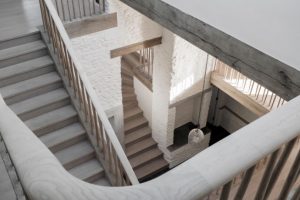 Coastal House, Devon by 6a architects, has been awarded the Arnold Laver Gold Award. The project was also the Interiors category winner. The interior of this house uses timber in several different ways to create a home which feels natural and unaffected.
Coastal House, Devon by 6a architects, has been awarded the Arnold Laver Gold Award. The project was also the Interiors category winner. The interior of this house uses timber in several different ways to create a home which feels natural and unaffected.
Coastal House, Devon is an early-twentieth century family home with extensive views of the sea. The house has been transformed by stripping it back to its stone walls. Originally raised on a plinth above a basement, the ground-floor has been lowered to the level of the ground. This has increased the size of the rooms and created elongated openings to the outside. A series of oak beams make up the exposed primary structure. The internal spaces have been completely reconfigured. Three floors on the north end of the house connect to two floors on the south. Each space has a distinct volume and ceiling height, with the central stair offering clear views through the whole house. Tapered oak verticals are used as supports throughout, including primary drawing room columns, external veranda posts and the stair spindles.
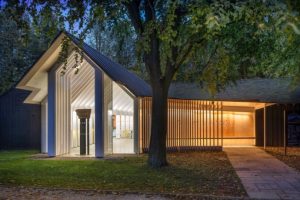 Commercial & Leisure
Commercial & Leisure
The judges selected Rievaulx Abbey Visitor Centre & Museum as the Commercial & Leisure winner as it does something highly unusual – it creates an abstract, numinous space using timber as an expressed structure.
The aim of the project was to upgrade the museum building to meet modern curatorial standards, encourage visitors into the ruins, and improve facilities.
Education & Public Sector
Maggie’s Oldham was chosen as the Education & Public Sector winner. dRMM created a sensitive interior that is also a world-first.
Built in the grounds of NHS cancer hospitals, Maggie’s Centres offer free practical and emotional support for people affected by cancer. The design of Maggie’s Oldham is less about form and more about content.
Supported on slender columns, the building floats above a garden framed by pine, birch and tulip poplar trees. From a central oasis, a tree grows up through the building, bringing nature inside. Maggie’s Oldham is the first permanent building constructed from sustainable tulipwood CLT. The slatted ceiling was created from wood left over from the CLT fabrication process, ensuring no waste. Externally the building is draped in custom-fluted, thermally modified tulipwood.
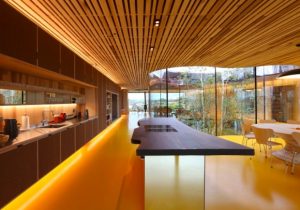 Private
Private
The winner of the Private category was Hampshire Passivhaus. The judges were impressed by the design, craftsmanship and attention to detail.
Hampshire Passivhaus is a self-build home on the south coast. It is an L-shaped detached dwelling, creating private courtyard spaces, on a tight brownfield site with multiple neighbours. Spruce CLT panels form the entire super structure, walls, floors and roof. The spruce panels give a tactile and harmonious quality to the living spaces and bedrooms. The prefabricated CLT superstructure was complete and watertight in just four days.
Small project
Feilden Fowles master-planned Waterloo City Farm from the design of animal pens, sheltered outdoor classroom and barn, to their new studio which was offered in exchange for their design services. The positioning of the studio against the north boundary creates a south-facing courtyard garden. The timber frame structure clad with corrugated Onduline sheets can be dismantled and re-erected when the lease comes to an end. The materiality and approach are reminiscent of agricultural building forms.
Structural Award
The Smile was awarded this year’s Structural Award, which was chosen from all the buildings shortlisted in each category. The judges were impressed by the ease with which The Smile masked some impressive and complex engineering.
Conceived as a habitable arc, The Smile was a 3.5m high, 4.5m wide and 34m long curved timber tube that cantilevered 12m in two directions with viewing platforms at both ends. Up to 60 visitors could enter at one time through an opening where the arc touched the ground. Innovative solutions using long screws were developed, allowing the opening to be in the most highly stressed region. The Smile was the first project in the world to use large hardwood CLT panels, the entire structure was made from just 12 tulipwood panels, each up to 14m long and 4.5m wide.
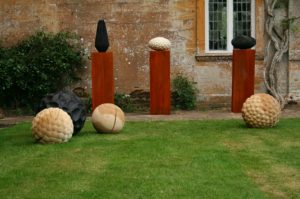 Bespoke
Bespoke
The winner of the Bespoke category was the Time and Texture Installation (‘A Landscape of Objects’). The judges praised the body of work which shows control and expression of the material.
Time and Texture is an installation of works forming part of ‘A Landscape of Objects’, a site-specific exhibition set in the gardens of Forde Abbey, curated by Flow Gallery for Somerset Art Works. The brief was to reference both the shapes, colours and texture of the gardens and buildings and the importance of water on the site. The installation is formed of three hollowed vessels on rusted plinths and four solid forms designed to show how natural elements erode and work away at materials. Through building up layers of texture through carving and sandblasting away the softer wood, it is possible to show how natural elements and processes layer and colour wood.
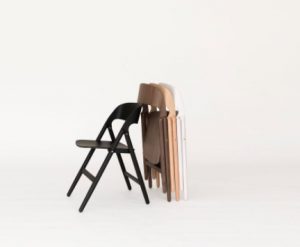 Production Made
Production Made
The judges awarded the Narin Chair the Production Made award for its elegant, distinctive, logical and comfortable design.
Student Designer
Within the Student Designer category there are two cash prizes; £1,000 for Winner and £500 for People’s Choice.
The category winner was Mark Laban’s Rustic Stool 1.0. The judges praised this new typology that creates a new aesthetic.
Through manipulating the machine’s software, unexpected and unconventional surfaces are created. These artificially generated rough textures begin to evoke the raw state of the material in its natural form. The stool is part of Mark Laban’s Digital Daiku collection, which interprets traditional Japanese aesthetic principles and explores their possibilities using contemporary digital manufacturing processes.
The People’s Choice Award was given to Damian Robinson’s Hex Drinks Cabinet which was inspired by a bees’ nest found in the maker’s garden.
Arnold Laver sponsors the Arnold Laver Gold Award which is the project that the judges deem to be the best of all the winners.
Major Sponsors included American Hardwood Export Council, the Carpenters’ Company, TRADA and the London Design Fair.
Other Sponsors comprised of American Softwoods, Forestry Commission, Timber Trade Federation, Wood for Good, the Furniture Makers’ Company and Party Ingredients.













